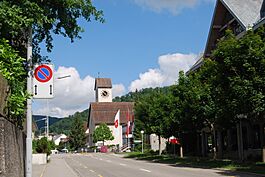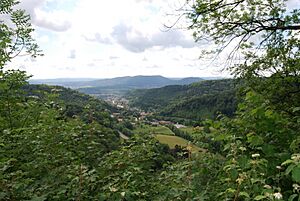Trimbach, Switzerland facts for kids
Quick facts for kids
Trimbach
|
||
|---|---|---|
 |
||
|
||
| Country | Switzerland | |
| Canton | Solothurn | |
| District | Gösgen | |
| Area | ||
| • Total | 7.6 km2 (2.9 sq mi) | |
| Elevation | 419 m (1,375 ft) | |
| Population
(Dec 2020 )
|
||
| • Total | 6,562 | |
| • Density | 863/km2 (2,236/sq mi) | |
| Postal code |
4632
|
|
| Surrounded by | Hauenstein-Ifenthal, Lostorf, Olten, Wangen bei Olten, Winznau, Wisen | |
Trimbach is a town in Switzerland, located in the canton of Solothurn. It's part of the Gösgen district and is known for its beautiful natural surroundings.
Contents
Trimbach's Past
Trimbach was first mentioned in old records in the year 1244. Back then, it was called Trinbach.
Exploring Trimbach's Geography
Trimbach covers an area of about 7.62 square kilometers (about 2.94 square miles). A big part of this land, about 52.4%, is covered by forests. Another 23.2% is used for farming, growing crops and raising animals. The rest of the land, about 23.8%, has buildings and roads.
The town is located between the Aare river and the Hauenstein Pass. It's also very close to the city of Olten, almost like a suburb. Trimbach includes the main village and smaller areas like Rumpel and Frohburg.
There's a discussion about Trimbach possibly joining with nearby towns like Hauenstein-Ifenthal, Wisen, and Olten in the future to form a new, larger community.
Trimbach's Coat of Arms
The official symbol, or blazon, of Trimbach's town coat of arms is a red rose on a silver background.
Who Lives in Trimbach?
Trimbach has a population of about 6562 people. About 34.2% of the people living here are from other countries.
Most people in Trimbach speak German, which is about 80.1% of the population. Italian is the second most common language, spoken by about 7% of the people, followed by Turkish at 2.9%.
In 2000, about 29.3% of the people living in Trimbach were also born there. Many others were born in the same canton or elsewhere in Switzerland.
Historic Sites in Trimbach
The Frohburg Castle ruins are a very important historical site in Trimbach. These ruins date back to the 12th to 14th centuries and are recognized as a special Swiss heritage site.
Trimbach's Economy
In 2010, Trimbach had an unemployment rate of 5%. Many people in Trimbach work in different areas:
- A small number work in farming and forestry.
- Many people work in the manufacturing and construction industries.
- The largest number of jobs are in the service sector, including sales, transportation, hotels, restaurants, education, and healthcare.
Trimbach is a place where more people leave for work than come in. About 20.7% of working people use public transportation to get to their jobs, while 47.6% use a private car.
Religion in Trimbach
According to a 2000 survey, about 43.4% of Trimbach's residents are Roman Catholic, and 25.3% belong to the Swiss Reformed Church. There are also people who belong to other Christian churches, as well as those who are Islamic, Buddhist, or Hindu. About 10.61% of the population do not belong to any church.
Getting Around Trimbach
Trimbach has its own train station, Trimbach railway station, which is on the Hauenstein Railway line. This makes it easy for people to travel to and from the town by train.
Education in Trimbach
Education is important in Trimbach. About 34.4% of the population has finished upper secondary education, and 8.3% have gone on to higher education at a university or a specialized college.
In the 2010-2011 school year, there were 693 students in Trimbach's schools.
- Young children can attend two years of optional Kindergarten.
- Students then go to six years of primary school.
- After primary school, there are three years of required secondary school, followed by optional advanced schools.
See also
 In Spanish: Trimbach (Soleura) para niños
In Spanish: Trimbach (Soleura) para niños










